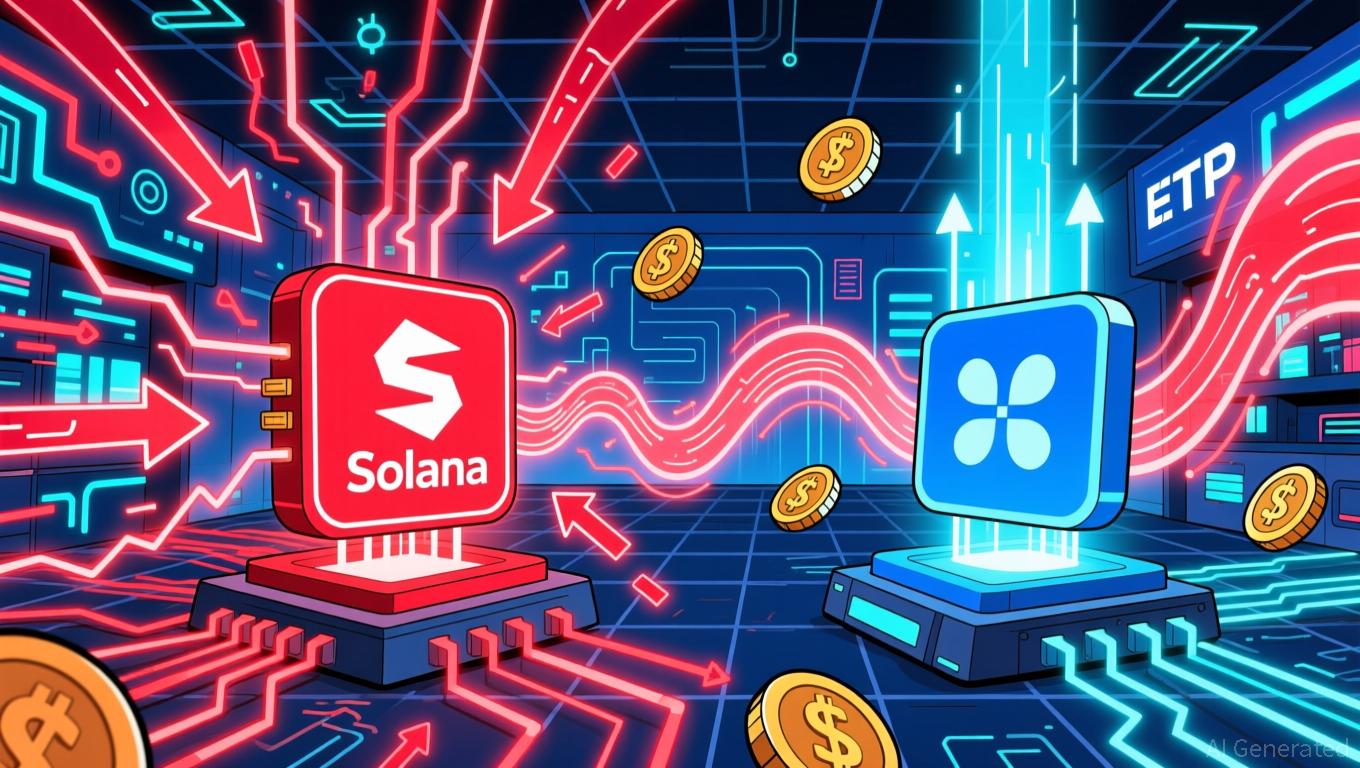The Unexpected Decline in PENGU Value: Reasons and What It Means for Investors
- Pudgy Penguins (PENGU) token fell 30% in late November 2025 due to regulatory uncertainty, algorithmic trading triggers, and a $66.6M team wallet outflow. - Market analysis highlights PENGU's reliance on speculative momentum and USDT liquidity, exposing it to volatility amid shifting sentiment and regulatory scrutiny. - Despite holding key support levels and showing increased institutional activity, PENGU faces structural risks from USDT dependency and tightening global crypto regulations. - The crash mi
PENGU Token Faces Steep Decline: What’s Behind the Drop?
Between November 13 and 18, 2025, the Pudgy Penguins (PENGU) token experienced a dramatic 30% plunge, igniting heated discussions among traders and market observers. This rapid downturn—fueled by a mix of regulatory ambiguity, automated trading responses, and a significant $66.6 million withdrawal from a team-controlled wallet—highlights the vulnerability of sentiment-driven cryptocurrencies. While some investors see the dip as a chance to buy, others warn that PENGU’s dependence on speculative trading and USDT liquidity could lead to further instability. This article explores the underlying causes of the decline, its broader impact on similar tokens, and whether current conditions present an opportunity or a warning for investors.
Main Drivers Behind the PENGU Sell-Off

- Regulatory Misunderstandings: The sell-off began after news of a regulatory probe, which was later clarified to be standard compliance checks. This confusion triggered algorithmic trading systems, accelerating the price drop.
- Large Wallet Movements: A $66.6 million outflow from a team wallet raised fears of major sell-offs, shaking investor trust.
- Technical Weakness: Indicators like MACD and On-Balance Volume signaled declining momentum, confirming a shift in market sentiment.
Adding to the turmoil, the launch of the Pudgy Party game initially sparked optimism but ultimately led to a 28.5% price decrease as doubts emerged about the token’s real-world utility and long-term prospects. This pattern is common among meme and NFT tokens, where hype often overshadows actual value, leaving them exposed to sharp corrections when sentiment turns.
Market Response and Signs of Stabilization
Despite the steep fall, PENGU has managed to stay above key support zones. Some market analysts predict a possible recovery toward $0.02 as buyers re-enter the market. On-chain data shows a 33% increase in trading activity, reaching $202 million, with $9.4 million attributed to large-scale investors or institutions. However, the Relative Strength Index (RSI) has climbed to 78.12, indicating that the token may be overbought and could face another short-term pullback.
Investor sentiment is divided. Retail traders remain optimistic about ecosystem developments, including partnerships with major retailers and the Pudgy World metaverse. In contrast, institutional analysts caution that PENGU’s heavy reliance on USDT (which accounts for 82.5% of its centralized exchange volume) makes it susceptible to liquidity shocks and regulatory changes, especially as the market shifts toward more regulated stablecoins like USDC.
Wider Lessons for Sentiment-Driven Crypto Assets
PENGU’s recent volatility echoes trends seen in other meme and NFT tokens. For example, the “Vulgar Penguin” token recently dropped 12.56% in a single day due to profit-taking and failed technical support. These cases demonstrate how speculative trading and limited practical use can amplify price swings in tokens popular with retail investors.
Academic studies reinforce this view, noting that the value of meme coins and NFTs is often shaped by online communities and hype, rather than fundamentals. This trend turns digital assets into speculative vehicles, making them especially vulnerable to sudden downturns when market sentiment shifts.
Opportunity or Warning Sign?
- Bullish Perspective: Supporters argue that PENGU’s expanding ecosystem—including the proposed Canary PENGU ETF—could attract institutional money and stabilize prices. Technical patterns, such as a double-bottom near $0.020, suggest a possible rebound to $0.027.
- Cautious Outlook: Critics point to the risks posed by PENGU’s dependence on USDT and exposure to tightening global regulations, such as the EU’s MiCA and the U.S. GENIUS Act. With a market capitalization of $826.54 million, PENGU sits at a crossroads between growth potential and broader economic pressures.
Final Thoughts
PENGU’s price collapse serves as a stark reminder of the dangers inherent in sentiment-driven crypto investments. While short-term traders may benefit from volatility, those with a long-term outlook must carefully weigh ecosystem progress against underlying vulnerabilities. The broader takeaway for similar tokens is clear: sustainable value and regulatory compliance are essential for long-term success. As the cryptocurrency landscape evolves, projects that fail to adapt risk fading into obscurity rather than achieving lasting prominence.
Disclaimer: The content of this article solely reflects the author's opinion and does not represent the platform in any capacity. This article is not intended to serve as a reference for making investment decisions.
You may also like
Ethereum News Update: Amundi’s Integrated Approach Connects Blockchain with Conventional Financial Regulations
- Amundi, Europe's largest asset manager, launched its first Ethereum-based tokenized money-market fund, enabling 24/7 settlements and transparent record-keeping via blockchain. - The hybrid model, developed with CACEIS, combines traditional fund operations with blockchain-based ownership, preserving regulatory compliance while expanding investor access. - Ethereum's dominance in stablecoin and RWA transfers ($105.94B in 30 days) underscores its role in accelerating tokenization, with Amundi positioning it

XRP News Today: XRP ETFs Drive Price Increases, While Solana ETFs Ease Selling Pressure
- XRP ETFs raised $587M in inflows since late November, outpacing Solana's $568M as investors favor altcoins with regulatory clarity and utility. - Bitwise XRP ETF's $107M debut and zero-fee strategy drove momentum, while Solana ETFs faced $156M weekly outflows due to network reliability concerns. - XRP's inflows acted as a "battering ram" pushing prices above $2.27, contrasting Solana's ETFs which merely dampened sell pressure without reversing its decline. - Analysts predict XRP could reach $3 by Decembe

The Federal Reserve's Change in Policy and Its Impact on Alternative Cryptocurrencies Such as Solana
- Fed's 2025 policy shifts, including rate cuts and stablecoin regulations, are reshaping altcoin markets by altering liquidity and risk appetite. - Solana's Alpenglow upgrade (150ms finality, 1M TPS) addresses scalability issues, aligning with Fed's AI-driven infrastructure focus despite network reliability concerns. - Institutional inflows into Solana ETFs ($100M AUM) contrast with retail caution (78% HODLers in red), highlighting divergent risk perceptions amid 30% price corrections. - Divergent ETF flo

Avail's Intent-Driven Nexus Addresses the Issue of Fragmented Liquidity Across Chains
- Avail launches Nexus Mainnet, a cross-chain solution unifying liquidity across Ethereum , Solana , and EVM networks. - The intent-solver model enables seamless asset transfers without technical complexities, streamlining user experiences. - Developers gain modular tools for multichain integration, reducing costs as cross-chain liquidity demand grows. - Nexus abstracts execution layers, offering unified balances and execution while addressing fragmentation challenges. - With $50B+ in cross-chain activity
